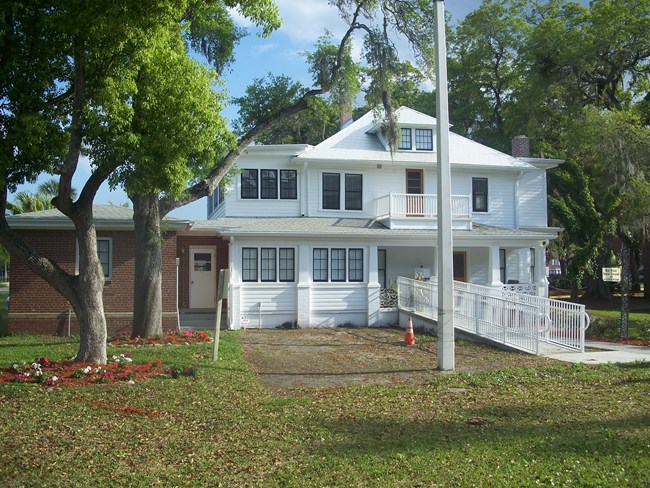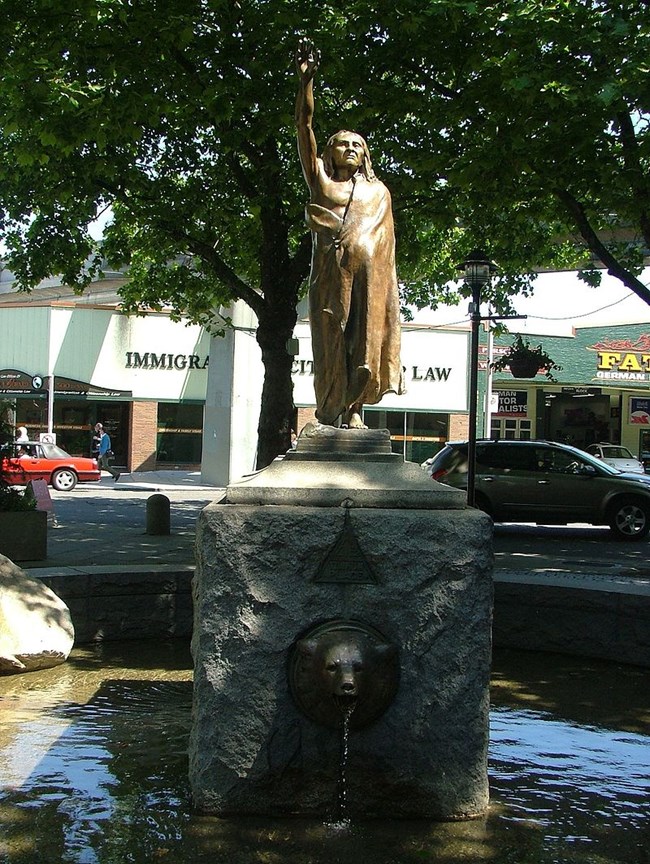Part of a series of articles titled Teaching with Historic Places Program and Where Did History Happen?: Selections from CRM, Vol 16, no 2 (1993).
Article
Teaching with Historic Places: Notes on Location and Place

Photo by Ebyabe, CC BY-SA 3.0, https://commons.wikimedia.org/w/index.php?curid=14803798
Selections from a Thematic Issue of CRM Vol 16 No. 2 1993
Published by the National Park Service, Cultural Resources
By: Salvatore J. Natoli
Notes on Location and Place
At first glance, location and place are not evocative terms. Location, from the Latin locus meaning “place,” becomes either absolute or relative in geographical usage. Place – variously derived from the middle English/old French “open space,” Latin “broad street,” Greek “broad” or “flat,” and the Spanish “plaza” – becomes invested with all manner of characteristics. Yet “place” is a useful term in geography, and much more evocative than the general public’s picture of the essence of geography – place name location.
The chief mathematical components of location are latitude and longitude, the intersection of which gives us a precise location in degrees, minutes, and seconds. As map projections of the earth’s surface, they permit us to see absolute locations, which are indispensable for developing exact navigational systems: missiles can be programmed to hit targets at these mathematical coordinates, satellite imagery gives measurements of earth phenomena, and airlines and steamships require precise coordinates for plotting their routes. Absolute location is a global address. In contrast, we frequently personalize relative location: “Where were you born?” “In Reading, Pennsylvania. It is in southeastern Pennsylvania, on the Schuylkill River, midway between Philadelphia and Harrisburg.” We do not say 40.20° N. lat., 75.55° W. long. Relative location always provides a reference point to other points, introduces environmental characteristics, and provides some measures of distance and direction.
One of the Oxford English Dictionary definitions of “place” is “a particular part of space, of defined or undefined extent, but of definite situation, sometimes applied to a region or part of the earth’s surface.” Two parts of this definition are crucial to geographers: the distinction between defined and undefined space, and the requirement for a definite situation. According to the Guidelines for Geographic Education: Elementary and Secondary Schools (Joint Committee on Geographic Education 1984, 4-5), “place” refers to the physical and human environmental characteristics that describe an area on the earth’s surface. It is an introductory descriptive term that sets up a series of identifying characteristics or clues. For example, a book on the Scoot and Amundsen south polar expeditions is titled, The Last Place on Earth (Huntford 1979).
J. Nicholas Entriken (1991) stated, “Place presents itself to us as a condition of human experience. As agents in the world we are always ‘in place,’ much as we are always ‘in culture.’ For this reason our relations to place or culture become elements in the construction of our individual and collective identities.” An entire genre of literature demonstrates the meaning of place in one’s perceived life experiences. Countless novels set moods and define experiences that are closely influenced by places. John Steinbeck’s Tortilla Flat, James Michener’s numerous novels, Garrison Keillor’s Lake Wobegon Days, and Emily Bronte’s Wuthering Heights are but a few examples. Novelists such as William Faulkner, Reynolds Price, Willa Cather, and Flannery O’Connor have profoundly influenced our images of certain places.
Fred Lukerman (1964, 167-172) identifies at least six constitutent values of places: location, ensemple (integration of nature and culture), uniqueness (within an interconnected framework), localized focusing power, emergence (within a historical-cultural sequence of change), and meaning. Thus we can define a place as a specific site or situation with a particular set of distinguishing human and natural characteristics – different from, but related to, other places; distinctive for attracting a variety of human activities; stamped by a specific history, but continually changing; and having real meaning as a result of these aspects and characteristics.

By Jan Kronsell, Public Domain, https://commons.wikimedia.org/w/index.php?curid=1506882
Lukerman omits methods for delimiting places, objective measurements, attention to scale, and all the most ambiguous means of generalization. What we do find is considerable subjectivity. Because values are difficult to measure, careful, deliberate, and detailed observations are integral to developing formal concepts of the region, and essential for demonstrating landscape elements to compare and contrast with other places.
Jakle, Brunn, and Roseman (1976) state that people are stereotyped by the kinds of places where they live, and places also become stereotyped by the kinds of people found in them. Thus, persons entering a place for the first time search for cues with which to assign meaning to a place. Prior knowledge of a place might interfere with an objective appraisal by clouding or masking cues, but stereotypes also provide useful frames of reference that we can modify by careful observation.
Perception has been an important research avenue in geography for more than two decades. Perception depends on more than the stimulus present and the capabilities of the sense organs. It varies also with the individual’s past experience and present attitude acting through values, needs, memories, moods, social circumstances, and expectations. Measuring perception is problematical because people have difficulty in articulating their conscious and unconscious feelings, or ideas associated with perception. In many cases perception must be inferred from behavior or from other indirect sources (Saarinen 1976, 6-8).
Places can instruct us. John Brinkerhoff Jackson’s writings on the vernacular landscape illustrate how we can read and understand current and past lives and activities from the revealed landscape. His work considers the problem of aesthetics, especially when townspeople may overlook the real advantages of the local environment and destroy the very vitality they hope to create by a more pleasurable visual landscape (Jackson 1970, 14-19; Jackson 1984).
Various clues signal the history and development of a place. European and Asian cities portray vividly not only historical periods but levels of development that add complexity and even charm. American historical consciousness recently has led to wholesale reconstruction or salvaging of our heritage: Society Hill in Philadelphia, the Faneuil Hall area in Boston, Colonial Williamsburg. Even newer cities such as Seattle, Portland, and San Diego now recognize the need to conserve part of their past. The Teaching with Historic Places series in Social Education attaches special significance to ordinary places in our historical heritage.
By careful observation we can identify age differences among places. Some of the newer towns in the American West have a temporary or even unfinished look, and the proportion of new buildings to old is high. Contrast the modernity of Tokyo, obliterated by bombers during World War II, with the historical temples of Kyoto, which were spared. Kevin Lynch, in his classic work, What Time is This Place? (1976) noted: “Places and events can be designed to enlarge our sense of the present, either by their own vivid characters or as they heighten our perception of the contained activity – setting off the people in a parade, an audience, or a market.”
Julian Wolpert (1965, 159-169) defined “place utility,” another facet of place perception, as a composite measure of the attractiveness or unattractiveness of an alternative location as perceived by a decision-maker. A function of levels of information, learning, and search activity, place utility is generally used to analyze migration decisions.
Places are building blocks for geographical knowledge; providers of experience in making sense of the landscape; stages for events; and reminders that humans require space to live, work, play, and prosper. People create and imprint places according to their distinctive knowledge, levels of technology, historical development, and even whimsy. Places are involved in important decisions, both personal and corporate. Places embody all of the themes and narratives of geography and the vital themes of history.
Think of the city, town, settlement, or farm where you were born or where you now live. How complete, comprehensive, or accurate a picture can you paint for those who have never lived there? Will their perceptions and experiences allow them to imagine it in some way similar to what it is or how you see it? How have your perceptions of this place changed over time? Another interesting activity is to draw a mental map of your hometown or area and then write about it as an article for a foreign-language magazine. When we attempt to convey the theme and concept of place to others, we are drawing upon their rich lode of experiences and testing their powers of observation and description.
When one can come to know and understand one’s place, with all its history, variety, and complexity, and how that place may have shaped one’s life and experiences, one might come to know and appreciate the importance of these creations to all people.
References:
Entriken, J. Nicholas. The Betweenness of Places: Toward a Geography of Modernity. Baltimore, MD: Johns Hopkins University Press, 1991.
Huntford, Roland. The Last Place on Earth. London: Hodder and Sloughton, 1979.
Jackson, John Brinkerhoff. “The Social Landscape,” in Landscapes: Selected Writings of J.B. Jackson, edited by Ervin H. Zube. Amherst: University of Massachusetts Press, 1970.
Jackson, John Brinkerhoof. Discovering the Vernacular Landscape. New Haven: Yale University Press, 1984.
Jackle, John A., Stanley Brunn, and Curtis Roseman. Human Spatial Behavior: A Social Geography. Nort Scituate, MA: Duxbury Press, 1976.
Joint Committee on Geographic Education, Association of American Geographers and National Council for Geographic Education. Macomb, IL and Washington, DC: National Council for Geographic Education and Association of American Geographers, 1984.
Lukerman, Fred. “Geography as a Formal Intellectual Discipline and the Way It Can Contribute to Human Knowledge,” Canadian Geographer 8 (1964): 167-172.
Lynch, Kevin. What Time is This Place? Cambridge, MA: MIT Press, 1976
Saarinen, Thomas F. Environmental Planning: Perception and Behavior. Boston: Houghton Mifflin, 1976: 6-8.
Wolpert, Julian. “Behavioral Aspects of the Decision to Migrate,” Papers, Regional Science Association 15 (1965): 159-169.
At the time of publication, Salvatore J. Natoli, geographer, was the Director of Publications and editor of Social Education for the National Council for the Social Studies.
Last updated: July 8, 2019
